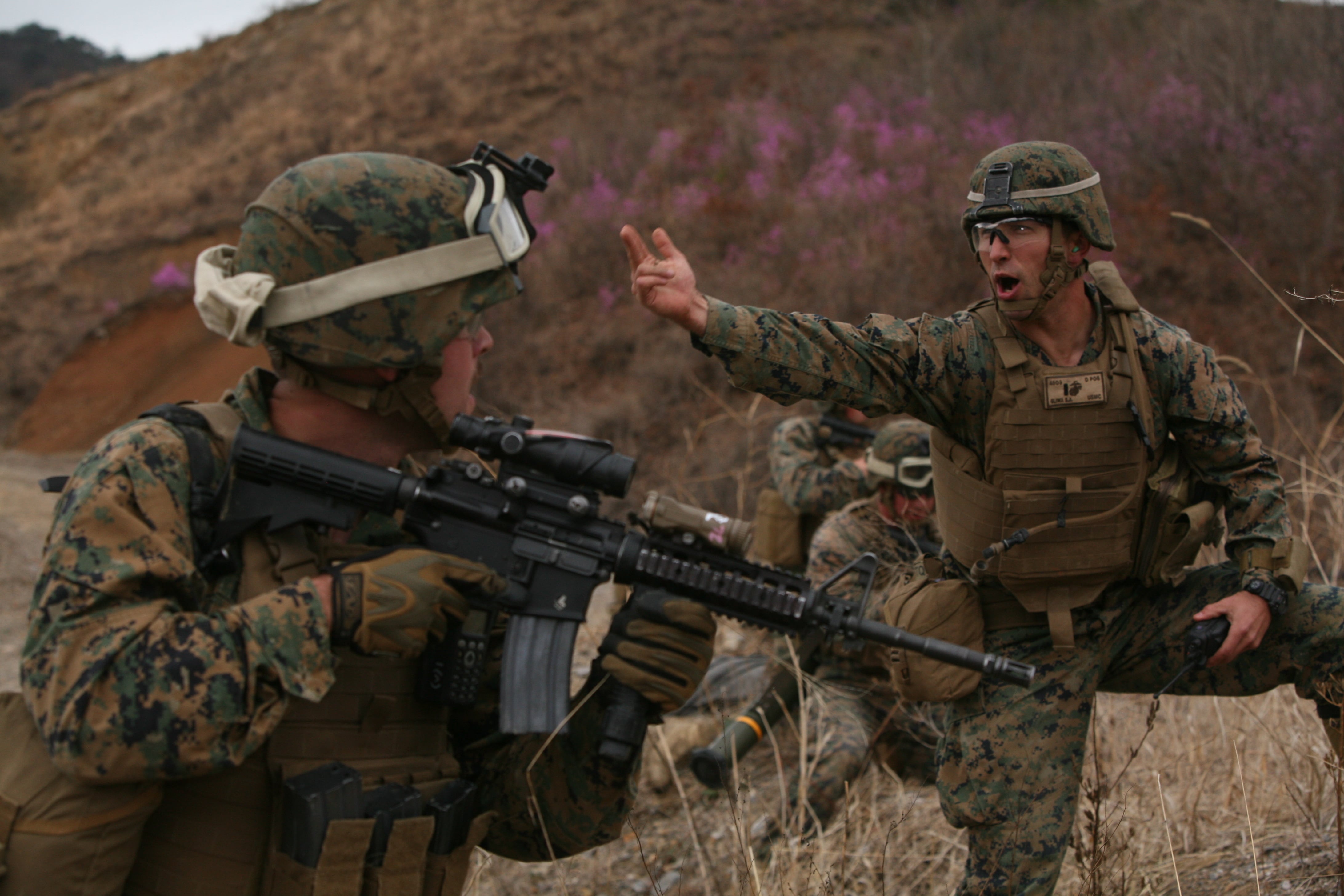A Marine Corps captain who "built the best infantry company" his commander said he's ever seen is this year's recipient of the service's prestigious Leftwich Trophy.
Capt. Thomas Morrow led Weapons Company, 2nd Battalion, 3rd Marines through a unique deployment to the Asia-Pacific region in 2015. Before they departed Hawaii, it would appeared to be just another six-month pump through Okinawa, Japan — but the deployment was unit deployment plan — months of training, qualifications, and exercises that led to a six-month pump to Okinawa. But this rotation was anything but typical.
By the end of it, Morrow's Marines were so motivated by their company's cohesion, they went as far as to get tattoos of an impromptu unit logo.
"No matter how controversial tattoos may be in the Marine Corps, it is a testament to how strongly the Marines believed in the team we had formed," Morrow told Marine Corps Times. said. "Personally, that felt great."
Though the battalion was focused on South Korea, Morrow's weapons company sent Marines quickly spread out across the region, and disaggregated operations became the norm. to every clime and place throughout the Pacific region. Disaggregated operations were the norm;
An 81mm mortar section trained with 5th Air and Naval Gunfire Liaison Company, or ANGLICO, in Okinawa while a scout sniper and mortar detachment plugged into a three-month partnership exercise with troops from Indonesia, Malaysia and Thailand. Morrow's Marines also provided combined-arms and air-assault support from mainland Japan to the Philippines.
Despite the distance, Weapons Company se obstacles there would emerged a tight-knit unit that would referred to itself as "the family." It's for the leadership that build that formidable force that Morrow was selected to receive the 2015 Lt. Col. William G. Leftwich Jr. Trophy for Outstanding Leadership.
Morrow "built the best infantry company I've observed while serving in five different infantry battalions over 20 years," said Lt. Col. Ryan Hoyle, 2/3's battalion commander, who has since made Morrow his battalion operations officer. In addition to his "mastery of fire support and employment of supporting arms in close proximity to maneuver," Hoyle said the his captain does not fatigue.
"He leans forward, anticipates friction, and gets the mission accomplished every time, in the right way," Hoyle said.
Building cohesion
Last year's Pacific deployment was a first for most of Morrow's junior Marines his company were new-joins who had never deployed. That was made a bit more challenging ough not an uncommon challenge, it was made more difficult when the first sergeant and key staff noncommissioned officers rotated out in the middle of work-ups.
But Morrow said he knew The captain knew he had something special when the company participated in an during the battalion’s assault at its Integrated Training Exercise , or ITX, held at Marine Corps Air-Ground Combat Center Twentynine Palms, California, before deploying. He Morrow ran the battalion's fire-support coordination center during the complex live-fire and maneuver attack, which was supported by close air, artillery, tanks, engineers and amphibious assault vehicles.
Everything was flowing; the Marines executed the breach without any hesitation. That, he said, was the moment he realized his company was now a cohesive unit — effective, lethal, and able to "absolutely do anything."
"I didn't expect any of this," Morrow said of getting the Leftwich award. told Marine Corps Times. "I am still convinced it is a clerical error, and my name was supposed to be stricken from this. ... It is clearly not me, and it is not an individual that earns this. It is a team effort. You could easily scratch my name and just leave Weapons Company 2/3 on there, and they would still rate this trophy above anyone else in the Marine Corps because they showed themselves to be the pinnacle of effectiveness as a team — and I am proud to be a part of that team."
Despite these obstacles there would emerge a tight-knit unit that would refer to itself as "the family," and would achieve success after success in disaggregated operations. Though spread thin, the Marines of Weapons Company, 2nd Battalion, 3rd Marine Regiment, 3rd Marine Division would make their presence and power known throughout the Pacific theater.
For the leadership that built this formidable force, Capt. Thomas Morrow on April 13 was named recipient of the 2015 Leftwich Trophy.
"As expected, the competition was exceptionally keen," Commandant Gen. Robert Neller said in his comments accompanying the official announcement. "All nominees had exemplary records which indicated noteworthy leadership and command ability."
On the surface, it would appear to be just another unit deployment plan — months of training, qualifications, and exercises that led to a six-month pump to Okinawa. But this rotation was anything but typical. Though the battalion was focused on Korea, weapons company sent Marines to every clime and place throughout the Pacific region. Disaggregated operations were the norm; An 81mm mortar section trained with 5th Air and Naval Gunfire Liaison Company, or ANGLICO, in Okinawa, while a scout sniper and mortar detachment plugged into a three-month partnership exercise with troops from Indonesia, Malaysia, and Thailand. Morrow's Marines provided combined arms and air assault support from mainland Japan to the Philippines.
While deployed, the Marines' exchange program with the Koreans was Korean Marine Exchange Program 15-12 stood as a key event for the battalion. The bilateral training exercise is designed to promote stability on the Korean Peninsula and strengthen the partnership between U.S. and South Korean troops. ROK and U.S. military capabilities and interoperability.
Weapons Company did not just train alongside ROK troops, but integrated their Korean counterparts into every facet of operations to mentor and build on the joint team. Morrow’s Marines put rounds on ranges that U.S. personnel have never visited, and also conducted some grueling training evolutions at the military's ROK Marine Corps ranger school in Gimpo, South Korea. That even earned them Republic of Korea ranger tabs.

First Lt. Stefan Gliwa, a platoon commander with Weapons Company, 2nd Battalion, 3rd Marines, gives a command Exercise Ssang Yong in South Korea. Capt. Thomas Morrow, Weapons Company's commander, was named the 2015 recipient of the Leftwich Trophy for his outstanding leadership.
Photo Credit: Sgt. Anthony Kirby/Marine Corps
The strong working relationship built with Korean counterparts enabled a successful two-battalion, combined-arms, live-fire exercise attack that integrated everything from Air Force A-10s to Korean tanks and Paladin artillery. That and won the praise of division leaders.
"He delivers decisive results, regardless of the mission, and his leadership has proven to be the critical enabler to his company's overall success," Col. Carl Cooper, the regimental commander, said in Morrow’s award submission package.
Unit leaders credited Morrow's philosophy of leadership much of the company's success. The veteran of Iraq and Afghanistan repeatedly stressed that "individual Marines and platoons can be strong, but collectively we are powerful." As they harnessed the power through unity, the team soon referred to itself as "the family." Some Marines went as far as to get tattoos of an impromptu unit logo.
"No matter how controversial tattoos may be in the Marine Corps, it is a testament to how strongly the Marines believed in the team we had formed," he said. "Personally, that felt great."
The Leftwich Trophy is awarded annually to a Marine captain in the ground combat arms community who "clearly and dramatically demonstrate[s] the ideals of courage, resourcefulness, perseverance, and concern for the well-being of our Corps and his enlisted Marines," according to the award criteria.
It's named for The Leftwich Trophy is named for Navy Cross and Silver Star recipient Lt. Col. William G. Leftwich Jr., who was killed in a 1970 helicopter crash while overseeing an emergency air extraction of a reconnaissance team in Vietnam. He was commanding officer of 1st Reconnaissance Battalion, 1st Marine Division, at the time.
Lance M. Bacon is senior reporter for Marine Corps Times. He covers Marine Corps Combat Development Command, Marine Corps Forces Command, personnel / career issues, Marine Corps Logistics Command, II MEF, and Marine Forces North. He can be reached at lbacon@marinecorpstimes.com.




